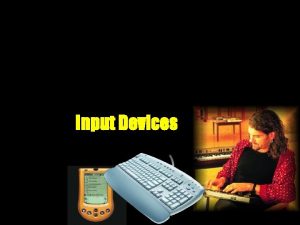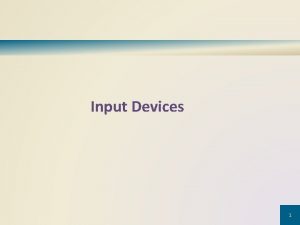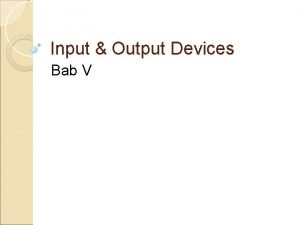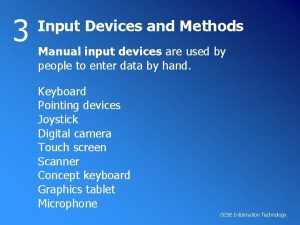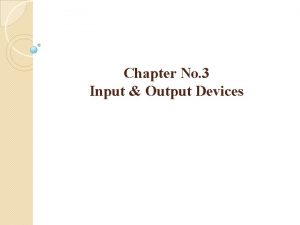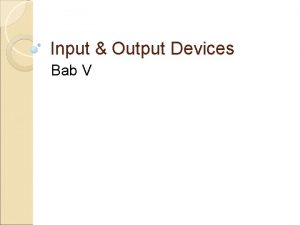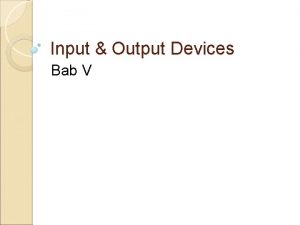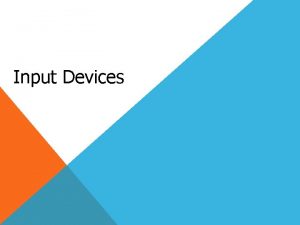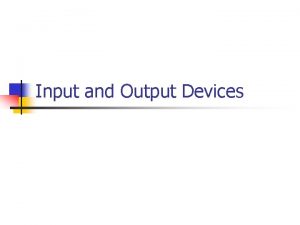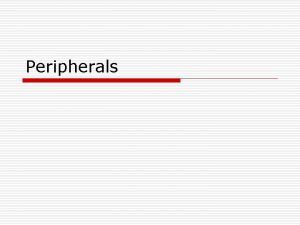Introduction to Input Devices Input Devices Units that
















- Slides: 16

Introduction to Input Devices

Input Devices Units that gather information and transform that information into a series of electronic signals for the computer.

Keyboard An arrangement of letters, numbers, and special function keys that act as the primary input device to the computer.

Mouse An input device that allows the user to manipulate objects on the screen by moving the mouse along the surface of the desk.

Sound Card A circuit board that gives the computer the ability to accept audio input, play sound files, and produce audio output through speakers or headphones.

Digital Camera Allows users to take pictures and store images electronically. Most digital cameras have built in internal flash memory to store pictures. The Three Basic Types of Digital Cameras Are: Field Cameras: has many lenses and other attachments Studio Cameras: stationary camera used for professional photography Point and Shoot: affordable and lightweight for general home and business use

Pointing Device An input device that allows a user to control a pointer on the screen. The location and shape change as the user moves the pointing device. Pointing Devices Include: Mouse Trackball Touchpad

Insertion Point A symbol on the screen that is usually blinking in the shape of a vertical bar. Used to indicate where the next character you type or item you insert will be place.

Scanner Light sensing input device that reads printed text and graphics and then translates the results into a form the computer can process. Allows users to capture data from an original source document and save in an electronic format.

Smart Phone A small hand held device that users can enter data and instructions using a variety of techniques. Ways to Input Using a Smart Phone: Draw or write on special paper with a digital pen Enter text-based messages via a wireless keyboard Speak into the microphone that wirelessly communicates with the phone Take a picture using the built in digital camera

Touch Screen A touch sensitive display device that allows users to interact with devices by touching various areas of the screen. Examples of Touch Screens: Smart Phones Airport Check-In Kiosk Grocery Store Self Check Out ATM’s

Modem A device that sends and receives data to and from computers over telephone/dsl/cable lines. Means (Modulate – Demodulate).

Barcode Reader A barcode reader (or barcode scanner) is an electronic device for reading printed barcodes. Like a flatbed scanner, it consists of a light source, a lens and a light sensor translating optical impulses into electrical ones.

Biometric Device The use of special input devices to analyze some physical parameter assumed to be unique to an individual, in order to confirm their identity as part of an authentication procedure. Types of Biometric Devices: Fingerprint Scanning Iris Recognition Voice Recognition Facial Recognition

KVM Switch KVM stands for "Keyboard, Video, Mouse. " A KVM switch connects one keyboard, one mouse and one video display to multiple computers. This allows users to control multiple computers with only a single set of input and output devices.

References www. wisegeek. com
 Phân độ lown ngoại tâm thu
Phân độ lown ngoại tâm thu Block nhĩ thất độ 2 mobitz 1
Block nhĩ thất độ 2 mobitz 1 Thơ thất ngôn tứ tuyệt đường luật
Thơ thất ngôn tứ tuyệt đường luật Thơ thất ngôn tứ tuyệt đường luật
Thơ thất ngôn tứ tuyệt đường luật Walmart thất bại ở nhật
Walmart thất bại ở nhật Tìm vết của đường thẳng
Tìm vết của đường thẳng Hãy nói thật ít để làm được nhiều
Hãy nói thật ít để làm được nhiều Tôn thất thuyết là ai
Tôn thất thuyết là ai Gây tê cơ vuông thắt lưng
Gây tê cơ vuông thắt lưng Sau thất bại ở hồ điển triệt
Sau thất bại ở hồ điển triệt Output devices of computer
Output devices of computer Botox placement
Botox placement Absorption costing income statement
Absorption costing income statement Literary device scanner
Literary device scanner Optical mark reader input or output
Optical mark reader input or output Chapter 1 introduction to the structural units answer key
Chapter 1 introduction to the structural units answer key Introduction to the structural units
Introduction to the structural units




















